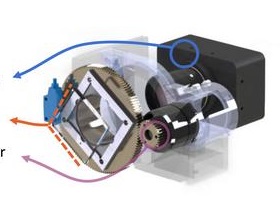University of Maryland researchers have developed a camera mechanism that enhances the visual capabilities of robots, smartphones, and other imaging devices by mimicking the involuntary movements of the human eye. The new system, called the Artificial Microsaccade-Enhanced Event Camera (AMI-EV), was detailed in a study published in the journal Science Robotics in May 2024.
Led by computer science Ph.D. student Botao He, the team addressed a key limitation of current event cameras, which are proficient in tracking moving objects but struggle with image clarity during rapid motion. The researchers drew inspiration from microsaccades, small and quick eye movements that help humans maintain clear vision on moving objects. They incorporated a rotating prism into the AMI-EV, which mimics these eye movements by continuously redirecting light beams captured by the lens, thereby stabilizing the visual textures of the recorded objects.
This innovative approach was further refined with software that compensates for the prism’s movement, consolidating stable images from shifting lights. Professor Yiannis Aloimonos, co-author of the study and director of the Computer Vision Laboratory at the University of Maryland Institute for Advanced Computer Studies, highlighted the advancement this represents in robotic vision, emphasizing that better cameras lead to improved perception and reaction in robots.
The AMI-EV’s potential applications extend beyond robotics. According to research scientist Cornelia Fermüller, the system’s superior performance in extreme lighting conditions, low latency, and low power consumption make it particularly suitable for smart wearables and virtual reality applications. In initial tests, the AMI-EV demonstrated its ability to capture and display rapid movements with high accuracy, outperforming typical commercial cameras by capturing tens of thousands of frames per second.
The team believes this new camera system could revolutionize various fields, including autonomous driving, security monitoring, and even astronomical imaging. By enhancing the ability of devices to discern and react to their environment with greater precision, the AMI-EV represents a significant step forward in imaging technology.
Image: Botao He, Yiannis Aloimonos, Cornelia Fermuller, Jinxi Chen and Chahat Deep Singh

